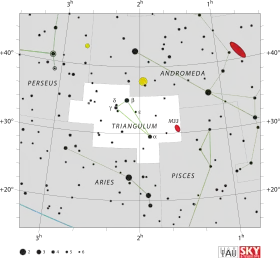Iota Trianguli
Iota Trianguli, Latinized from ι Trianguli, is a quadruple[3] star system in constellation of Triangulum. It is approximately 290 light years from Earth.
 | |
| Observation data Epoch J2000.0 Equinox J2000.0 (ICRS) | |
|---|---|
| Constellation | Triangulum |
| Right ascension | 02h 12m 22.28003s[1] |
| Declination | +30° 18′ 11.0430″[1] |
| Apparent magnitude (V) | +4.952[2] (5.32 + 6.83)[3] |
| Characteristics | |
| Spectral type | G0 III + G5 III[4] + F5V + ?[3] |
| U−B color index | +0.307[2] |
| B−V color index | +0.789[2] |
| Astrometry | |
| Proper motion (μ) | RA: −65.05[1] mas/yr Dec.: −60.50[1] mas/yr |
| Parallax (π) | 11.22 ± 0.70[1] mas |
| Distance | 290 ± 20 ly (89 ± 6 pc) |
| Absolute magnitude (MV) | +0.20[5] |
| Details | |
| Luminosity | 84[5] L☉ |
| Metallicity [Fe/H] | −0.48[5] dex |
| Other designations | |
| Database references | |
| SIMBAD | data |
Both components of ι Trianguli are spectroscopic binaries and the brighter pair is variable. It has been given the variable star designation TZ Trianguli. The variations are due to the ellipsoidal shape of the stars as they rotate, and also it is classified as an RS Canum Venaticorum variable.[7]
References
- van Leeuwen, F. (2007), "Validation of the new Hipparcos reduction", Astronomy and Astrophysics, 474 (2): 653–664, arXiv:0708.1752, Bibcode:2007A&A...474..653V, doi:10.1051/0004-6361:20078357.
- Rakos, K. D.; et al. (February 1982), "Photometric and astrometric observations of close visual binaries", Astronomy and Astrophysics Supplement Series, 47: 221–235, Bibcode:1982A&AS...47..221R.
- Eggleton, P. P.; Tokovinin, A. A. (September 2008), "A catalogue of multiplicity among bright stellar systems", Monthly Notices of the Royal Astronomical Society, 389 (2): 869–879, arXiv:0806.2878, Bibcode:2008MNRAS.389..869E, doi:10.1111/j.1365-2966.2008.13596.x.
- Harlan, E. A. (September 1969), "MK classifications for F- and G-type stars. I", Astronomical Journal, 74: 916–919, Bibcode:1969AJ.....74..916H, doi:10.1086/110881.
- Anderson, E.; Francis, Ch. (2012), "XHIP: An extended hipparcos compilation", Astronomy Letters, 38 (5): 331, arXiv:1108.4971, Bibcode:2012AstL...38..331A, doi:10.1134/S1063773712050015.
- "iot Tri". SIMBAD. Centre de données astronomiques de Strasbourg. Retrieved 2017-06-30.
- Hall, D. S.; et al. (1980), "6 iota Trianguli: A new variable star", Information Bulletin on Variable Stars, 1764: 1, Bibcode:1980IBVS.1764....1H.
External links
- Kaler, James B., "6 Trianguli", Stars, University of Illinois, retrieved 2017-07-01.
This article is issued from Wikipedia. The text is licensed under Creative Commons - Attribution - Sharealike. Additional terms may apply for the media files.